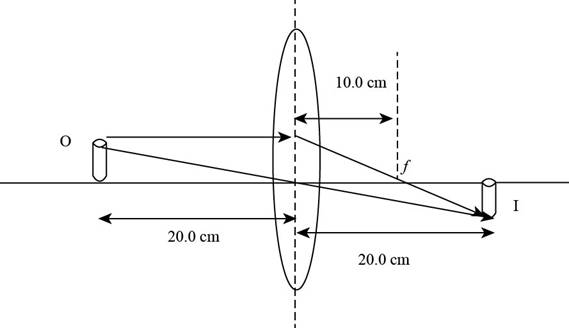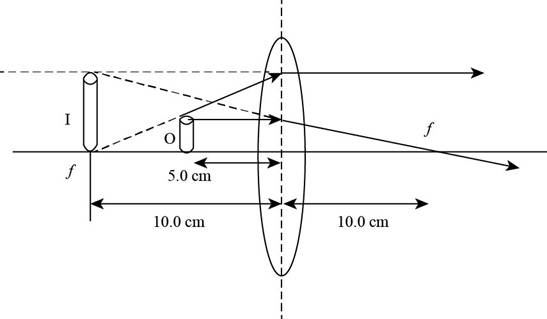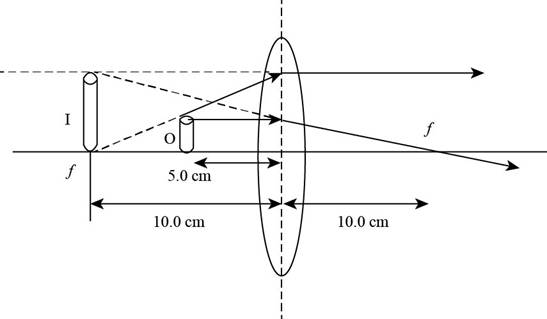
Concept explainers
(i)
To draw: The ray diagram for the given focal lengthy of the lens and the given object distance.
(i)
Answer to Problem 26P
The ray diagram of the given criteria is,

Explanation of Solution
Introduction:
In a ray diagram in the case of lens or mirror the image is formed where two at least refracted or reflected rays coincide with each other.
Given info: The position of object is at
The ray diagram is shown in the figure below.

Figure (1)
(ii)
To draw: The ray diagram for the given focal length of the lens and the given object distance.
(ii)
Answer to Problem 26P
The ray diagram of the given criteria is,

Explanation of Solution
Introduction:
In a ray diagram in the case of lens or mirror the image is formed where two at least refracted or reflected rays coincide with each other.
Given info: The position of object is at
The ray diagram is shown in the figure below.

Figure (2)
(a)
The location of the image the given cases.
(a)
Answer to Problem 26P
The image is at
Explanation of Solution
From Figure (1), it is evident that the image is formed on the rear end of the lens and the image distance measured is
From Figure (2), the image is formed at
Conclusion:
Therefore, the measured distance for the image for the case when object is at
(b)
The image is real or virtual.
(b)
Answer to Problem 26P
For the case when object is at
Explanation of Solution
From Figure (1), it is evident that the image is formed on the rear side and is real and the images formed at the back side of the lens are real.
From Figure (2), the image is formed at
Conclusion:
The images formed by the lens in front of it are virtual and erect and images formed on the back side are real and inverted. Hence, image formed by the object kept at.
(c)
The image is upright or inverse.
(c)
Answer to Problem 26P
For the case when object is at
Explanation of Solution
From Figure (1), it is evident that the image is formed on the rear side and is real. and
the real images are always inverted
From Figure (2), the image is formed at
The virtual images are always upright.
Conclusion:
Therefore, the images formed by the lens in front of it are virtual and erect and images formed on the back side are real and inverted. Hence, image formed by the object kept at.
(d)
The magnification of the image.
(d)
Answer to Problem 26P
For the case when object is at
Explanation of Solution
From Figure (1) it is evident that the image is formed on the rear side and is real and inverted the object height is
Formula to calculate the magnification is
For the object at
For the object at the distance of
Conclusion:
Therefore, for the case of object at
(e)
The difference between the value of the ray diagram and the algebraic calculation.
(e)
Answer to Problem 26P
The value obtained from the ray diagrams for the cases are same for the values obtained in the algebraic calculation.
Explanation of Solution
Given Info: The focal length of the give lens is
From Figure (1) the image distance for the object at
For algebraic calculation, the formula for the image distance is,
Here,
Substitute
Form figure (1) the magnification is
Formula to calculate the magnification of the image
Here
Substitute
From figure (2) the image distance is
From equation (4) formula to calculate the image distance is,
Substitute
The image distance is
From equation (6) the formula to calculate the magnification is,
Substitute
From equation (6) and equation (7) it is evident that for the case of object at
From equation (8) and (9) the image distance and magnification is same for the ray diagram and the algebraic case when the object is
Conclusion:
Therefore, the result for the ray diagrams and algebraic calculations are same.
(f)
The difficulties is making the graph which may lead to difference between the algebraic and graphical values.
(f)
Answer to Problem 26P
Human hand errors, Parallax errors and scale measurement errors could lead to difference in the values of graph and algebraic calculation.
Explanation of Solution
While drawing the graph the possible errors are human hand errors, parallax errors and scale measurement errors.
Human Hand Errors are while making the ray diagrams the rays might not converge with extreme precision. Parallax error/Human eye errors occur due to human eye. Scale errors are during the scale measurement.
Conclusion:
Therefore, the three most common errors that can lead to difficulties in constructing the graph which might lead to change the algebraic and graphical values are human hand errors, parallax errors and Scale errors.
Want to see more full solutions like this?
Chapter 35 Solutions
Physics for Scientists and Engineers with Modern Physics
- A converging lens made of crown glass has a focal length of 15.0 cm when used in air. If the lens is immersed in water, what is its focal length? (a) negative (b) less than 15.0 cm (c) equal to 15.0 cm (d) greater than 15.0 cm (e) none of those answersarrow_forwardThe left face of a biconvex lens has a radius of curvature of magnitude 12.0 cm, and the right face has a radius of curvature of magnitude 18.0 cm. The index of refraction of the glass is 1.44. (a) Calculate the focal length of the lens for light incident from the left. (b) What If? After the lens is turned around to interchange the radii of curvature of the two faces, calculate the focal length of the lens for light incident from the left.arrow_forwardTwo thin lenses of focal lengths f1 = 15.0 and f2 = 10.0 cm, respectively, are separated by 35.0 cm along a common axis. The f1 lens is located to the left of the f2 lens. An object is now placed 50.0 cm to the left of the f1 lens, and a final image due to light passing though both lenses forms. By what factor is the final image different in size from the object? (a) 0.600 (b) 1.20 (c) 2.40 (d) 3.60 (e) none of those answersarrow_forward
- How far should you hold a 2.1 cm-focal length magnifying glass from an object to obtain a magnification of 10 x ? Assume you place your eye 5.0 cm from the magnifying glass.arrow_forwardA diverging lens has a focal length of magnitude 20.0 cm (a) Locate the images for object distances of (i) 40.0 cm. (ii) 20.0 cm, and (iii) 10.0 cm. For each case, state whether the image is (b) real or virtual and (c) upright or inverted. (d) For each case, Find the magnification.arrow_forwardTwo stars that are 109km apart are viewed by a telescope and found to be separated by an angle of 105 radians. If the eyepiece of the telescope has a focal length of 1.5 cm and the objective has a focal length of 3 meters, how far away are the stars from the observer?arrow_forward
- A lamp of height S cm is placed 40 cm in front of a converging lens of focal length 20 cm. There is a plane mirror 15 cm behind the lens. Where would you find the image when you look in the mirror?arrow_forwardA diverging lens has a focal length of magnitude 20.0 cm. (a) Locate the image for object distances of (i) 40.0 cm, (ii) 20.0 cm, and (iii) 10.0 cm. For each case, state whether the image is (b) real or virtual and (c) upright or inverted.(d) For each case, find the magnification.arrow_forwardYou view an object by holding a 2.5 cm-focal length magnifying glass 10 cm away from it. How far from your eye should you hold the magnifying glass to obtain a magnification of 10 ?arrow_forward
- A converging lens has a focal length of 10.0 cm. Locate the object if a real image is located at a distance from the lens of (a) 20.0 cm and (b) 50.0 cm. What If? Redo the calculations if the images are virtual and located at a distance from the lens of (c) 20.0 cm and (d) 50.0 cm.arrow_forwardTwo converging lenses having focal length of f1 = 10.0 cm and f2 = 20.0 cm are placed d = 50.0 cm apart, as shown in Figure P23.44. The final image is to be located between the lenses, at the position x = 31.0 cm indicated. (a) How far to the left of the first lens should the object be positioned? (b) What is the overall magnification of the system? (c) Is the final image uptight or inserted? Figure P23.44arrow_forwardTwo converging lenses having focal lengths of f1 = 10.0 cm and f2 = 20.0 cm are placed a distance d = 50.0 cm apart as shown in Figure P35.48. The image due to light passing through both lenses is to be located between the lenses at the position x = 31.0 cm indicated. (a) At what value of p should the object be positioned to the left of the first lens? (b) What is the magnification of the final image? (c) Is the final image upright or inverted? (d) Is the final image real or virtual?arrow_forward
 College PhysicsPhysicsISBN:9781285737027Author:Raymond A. Serway, Chris VuillePublisher:Cengage Learning
College PhysicsPhysicsISBN:9781285737027Author:Raymond A. Serway, Chris VuillePublisher:Cengage Learning Principles of Physics: A Calculus-Based TextPhysicsISBN:9781133104261Author:Raymond A. Serway, John W. JewettPublisher:Cengage Learning
Principles of Physics: A Calculus-Based TextPhysicsISBN:9781133104261Author:Raymond A. Serway, John W. JewettPublisher:Cengage Learning Physics for Scientists and Engineers, Technology ...PhysicsISBN:9781305116399Author:Raymond A. Serway, John W. JewettPublisher:Cengage Learning
Physics for Scientists and Engineers, Technology ...PhysicsISBN:9781305116399Author:Raymond A. Serway, John W. JewettPublisher:Cengage Learning Physics for Scientists and EngineersPhysicsISBN:9781337553278Author:Raymond A. Serway, John W. JewettPublisher:Cengage Learning
Physics for Scientists and EngineersPhysicsISBN:9781337553278Author:Raymond A. Serway, John W. JewettPublisher:Cengage Learning Physics for Scientists and Engineers with Modern ...PhysicsISBN:9781337553292Author:Raymond A. Serway, John W. JewettPublisher:Cengage Learning
Physics for Scientists and Engineers with Modern ...PhysicsISBN:9781337553292Author:Raymond A. Serway, John W. JewettPublisher:Cengage Learning University Physics Volume 3PhysicsISBN:9781938168185Author:William Moebs, Jeff SannyPublisher:OpenStax
University Physics Volume 3PhysicsISBN:9781938168185Author:William Moebs, Jeff SannyPublisher:OpenStax





